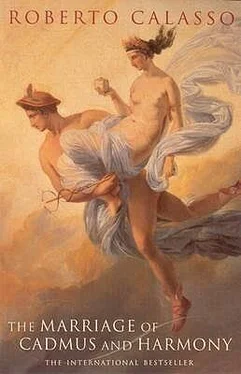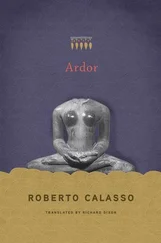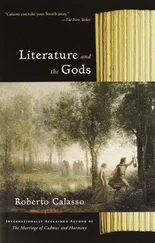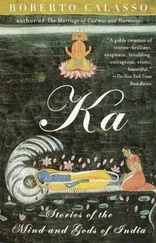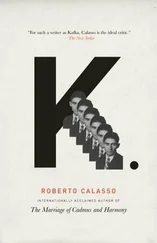Roberto Calasso - The Marriage of Cadmus and Harmony
Здесь есть возможность читать онлайн «Roberto Calasso - The Marriage of Cadmus and Harmony» весь текст электронной книги совершенно бесплатно (целиком полную версию без сокращений). В некоторых случаях можно слушать аудио, скачать через торрент в формате fb2 и присутствует краткое содержание. Год выпуска: 1993, Издательство: Alfred A. Knopf Inc, Жанр: Современная проза, на английском языке. Описание произведения, (предисловие) а так же отзывы посетителей доступны на портале библиотеки ЛибКат.
- Название:The Marriage of Cadmus and Harmony
- Автор:
- Издательство:Alfred A. Knopf Inc
- Жанр:
- Год:1993
- ISBN:нет данных
- Рейтинг книги:3 / 5. Голосов: 1
-
Избранное:Добавить в избранное
- Отзывы:
-
Ваша оценка:
- 60
- 1
- 2
- 3
- 4
- 5
The Marriage of Cadmus and Harmony: краткое содержание, описание и аннотация
Предлагаем к чтению аннотацию, описание, краткое содержание или предисловие (зависит от того, что написал сам автор книги «The Marriage of Cadmus and Harmony»). Если вы не нашли необходимую информацию о книге — напишите в комментариях, мы постараемся отыскать её.
The Marriage of Cadmus and Harmony — читать онлайн бесплатно полную книгу (весь текст) целиком
Ниже представлен текст книги, разбитый по страницам. Система сохранения места последней прочитанной страницы, позволяет с удобством читать онлайн бесплатно книгу «The Marriage of Cadmus and Harmony», без необходимости каждый раз заново искать на чём Вы остановились. Поставьте закладку, и сможете в любой момент перейти на страницу, на которой закончили чтение.
Интервал:
Закладка:
In the thick of the stones, marble, and metal at Delphi, the visitor would think of other ghosts, of the first temples to Apollo, now no more. The first, a hut of laurel branches broken from trees in the valley of Tempe; the second, made of wax and feathers; the third, built in bronze by Hephaestus and Athena. Pindar could still wonder: “Oh Muses, with what patterns did the able hands of Hephaestus and Athena decorate the temple?” We shall never know, but Pindar thought he could recall fragments of an image: “Bronze the walls and bronze too rose the columns; golden above the pediment chanted six Enchantresses.” These words were already sounding obscure by the time Pausanias heard them. At most, he supposed, the Enchantresses might have been an “imitation of Homer’s Sirens.” Yet they held the secret to a long story, the story of the origins of possession.
Iynx was a girl sorceress. She made up love potions. Not for herself, but because she wanted love to make the rounds. One day she offered a drink to Zeus. The god drank it, and the first girl he saw was Io, wandering about in the grounds of Hera’s sanctuary in Argos. Zeus was possessed by love for Io. And so began history on earth, a history of flight, persecution, metamorphosis. The first victim was the sorceress herself. In revenge, Hera turned her into a bird known as the wryneck, because of the way it twists its neck with a sudden jerking movement. When Jason reached Colchis, he knew that if he wanted to get the Golden Fleece he would have to win over the young sorceress Medea. Aphrodite looked down from heaven and decided to help him. A sorceress can only be overcome by a more potent sorcery. So Aphrodite took the wryneck, the “delirious, multicolored bird,” and fixed it with bonds that could not be untied to a little wheel with four spokes. Now the circular motion of the wheel would forever accompany the jerky twisting of the bird’s neck. That small object, that plaything, becomes the mechanism, the artifice of possession. It imposes an obsessive circular motion on the mind, a motion that uproots it from its inertia and hooks it onto the divine wheel, which turns incessantly like the spheres. Even the thoughts of the gods get caught on that wheel.
Jason learned to use Aphrodite’s gift. Medea immediately lost all consideration for her parents. The girl’s mind was obsessed by desire for a distant country, for a name, Greece, which she confused with Jason’s presence. Thus, drawing on her sorcery, her herbs and ointments, Medea saved the Stranger and ruined her own family. It wasn’t Apollo or Dionysus, then, lords of possession that they were, who invented the íynx , this strange object that is the only visible artifact of possession. Aphrodite, goddess of “the swiftest arrows,” got there first; for erotic possession is the starting point for any possession. What at Delphi is an enigma, for Aphrodite is a plaything. The worshipers at Apollo’s temple in Delphi would see small wheels hanging from the ceiling, small wheels with the bodies of birds attached. It was said that those wheels produced a voice, a seductive call. They were the Enchantresses Pindar spoke of, linking the human mind to the circular motion of the heavens.
The boy Apollo straightens in his mother Leto’s arms and lets fly an arrow at an enormous snake wrapped in huge coils around the dappled slopes of Delphi. The youth Apollo, wavy, blond hair falling on his shoulders, chases after a young girl. Just as he is about to catch her, the girl turns herself into a laurel tree. Each of these actions is the shadow of the other. If we look carefully at Python, we can see the delicate Daphne in the snake. Looking at the laurel leaves, we can see the scales of Python.
No sooner have you grabbed hold of it than myth opens out into a fan of a thousand segments. Here the variant is the origin. Everything that happens, happens this way, or that way, or this other way. And in each of these diverging stories all the others are reflected, all brush by us like folds of the same cloth. If, out of some perversity of tradition, only one version of some mythical event has come down to us, it is like a body without a shadow, and we must do our best to trace out that invisible shadow in our minds. Apollo slays the monster, he is the first slayer of monsters. But what is this monster? It is Python’s skin, camouflaging itself among bushes and rock, and it is the soft skin of Daphne, already turning into laurel and marble.
Apollo doesn’t manage to possess the Nymph, and maybe he doesn’t even want to. What he is looking for in the Nymph is the crown of laurel left in his hand as her body dissolves: he wants representation. No Nymph could ever reject or escape Dionysus, because the Nymph is part of himself. There is only one exception, Aura, who has her double in Nikaia. But the rape of Aura would introduce Iacchus to the Eleusinian mysteries. Hence it could not be other than unique, in its initial duality.
The Nymph is possession, and a nymphólēptos is a person who becomes delirious on being captured by the Nymphs. Apollo does not possess the Nymphs, he does not possess possession, but he educates it, governs it. The Muses were wild young girls from Helicon. It was Apollo made them move over to the mountain opposite, Parnassus; it was he trained them in the gifts that made that band of wild girls the Muses, and hence those women who took possession of the mind, but each imposing the laws of an art.
Plutarch, priest of Delphic Apollo, claimed that Dionysus was just as important in Delphi as Apollo. In the freezing winter months, the months when the dead rise and torches wander about the slopes of Parnassus, Dionysus is lord of Delphi. But then Apollo returns from his nordic quest among the Hyperboreans, and for the other nine months of the year he reigns supreme. No victory is ever complete, nor ever enough to last the whole year. Neither Apollo nor Dionysus can reign forever, neither can do without the other, neither can be there all the time. When Apollo reappears and squeezes Dionysus’s arm, we hear the last notes of the dithyrambs, and immediately afterward the first of the paeans. The only continuity is sound.
In the Pythia’s ádyton , Apollo has a golden statue, Dionysus only the base of his tomb. Yet everything seems to proceed smoothly enough. As interlocking and alternating powers, Apollo and Dionysus are loath to let anything of their past emerge in this place. Few recall that, beneath the bronze lid of the tripod where the Pythia now sits, the dismembered limbs of Dionysus Zagreus once boiled. Or even that Dionysus, as some claim, was the first to prophesy from the tripod. Or even that a snake once coiled around the feet of that tripod. All this would have made it all too easy to confuse the stories of Dionysus with those of the Enemy: Python, a snake, and thus close to Dionysus, the god generated by Zeus when in the form of a snake and escorted by virgins who tied snakes around their foreheads like ribbons; Python forerunner of Apollo as prophet; Python who was himself (or herself) buried in the ádyton , beneath the omphalós . Had all this been remembered, Dionysus, who reigned in Apollo’s stead during his winter absence, would have been revealed in his occult role as the Enemy, an emanation of Python, of the power Apollo had killed and left to rot in the sun.
In its heyday, and likewise in its decadence, Delphi was the opposite of what the Hellenophiles of the last century imagined as the classical spirit. It was a market, a hoard of trophies, a burial ground. Its guiding principle demanded accumulation. Shields and figureheads, the gifts of victorious soldiers. Lyres, tripods, chariots, bronze tables, basins, paterae, caldrons, wine bowls, spits: such was the vision that greeted the eye in the mégaron of Apollo’s temple. Leading through to the Pythia’s chamber, this hall was cluttered with objects leaning against the walls and columns, and hanging from the ceiling. Each of these objects was an event, summed up a life, sometimes many lives and many deaths. Up in the air, moving ever so slightly when a draft slipped in from outside, hung light chariot wheels. And the sashes and bands of athletes drifted back and forth like gossamer fans.
Читать дальшеИнтервал:
Закладка:
Похожие книги на «The Marriage of Cadmus and Harmony»
Представляем Вашему вниманию похожие книги на «The Marriage of Cadmus and Harmony» списком для выбора. Мы отобрали схожую по названию и смыслу литературу в надежде предоставить читателям больше вариантов отыскать новые, интересные, ещё непрочитанные произведения.
Обсуждение, отзывы о книге «The Marriage of Cadmus and Harmony» и просто собственные мнения читателей. Оставьте ваши комментарии, напишите, что Вы думаете о произведении, его смысле или главных героях. Укажите что конкретно понравилось, а что нет, и почему Вы так считаете.
